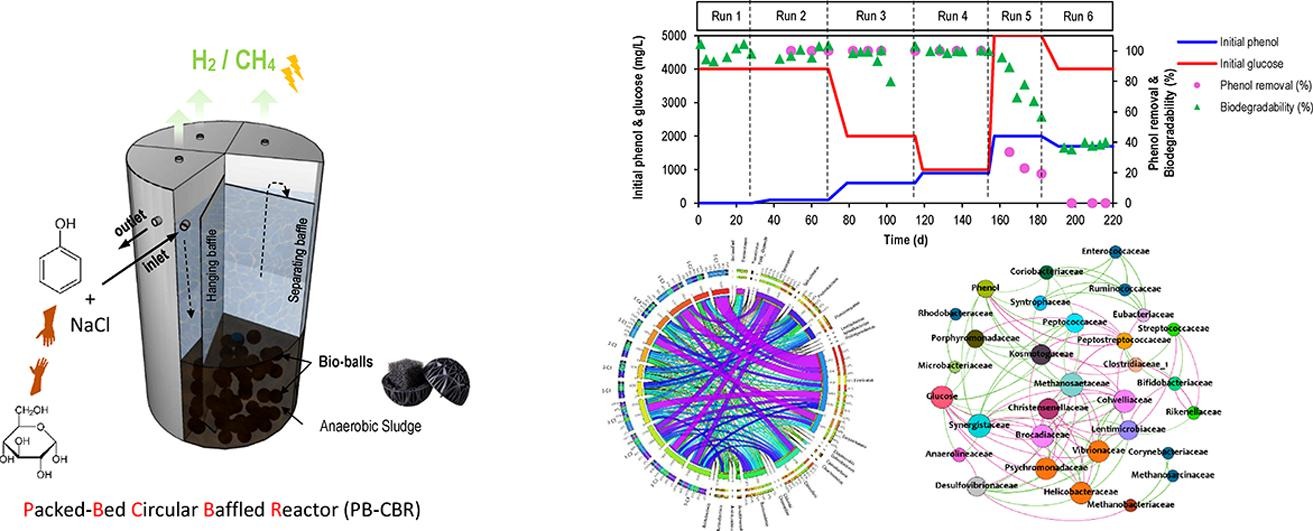
ナノ材料を活用した革新的嫌気性消化技術の開発 & 環境微生物キーストーン種の推定 / Development of innovative anaerobic digestion technology using nanomaterials & Estimation of keystone species in environmental microbiota
【ナノ材料を活用した革新的嫌気性消化技術の開発/Development of innovative anaerobic digestion technology using nanomaterials】
再生可能エネルギーによる持続可能な社会の実現へ向け、廃棄物やバイオマスからのエネルギー生産技術の開発は重要な社会的課題です。嫌気性消化技術は、廃棄有機物を有用なエネルギー源(水素ガスやエタノール、メタンガス)に変換できる微生物を活用した下排水処理技術として知られています。下排水処理工程で排出される廃棄活性汚泥は最も多い産業廃棄物の一つですが、この廃棄有機物を効果的にエネルギー源に変換することができれば、温室効果ガスの排出を抑えることができ、持続可能な社会の構築に向けて重要な一歩となります。従来から、嫌気性消化技術はクリーンな廃棄物処理として注目を浴びているものの、微生物による処理速度が遅いことがボトルネックでした。そこで本研究では、新たにナノ材料(ナノカーボンやナノ金属粒子、それらの複合材料)に着目し、反応槽にこれらのナノ材料を添加することで、嫌気性消化処理ならびにバイオガス(水素ガス)生産における反応効率化を目指しています。嫌気性消化におけるナノ材料の役割(機能)としては、微生物の栄養素となる微量必須金属の供給、ナノ材料の高い伝導性による微生物間の電子移動(DIET)効率化、また、酵素反応における補助剤などが考えられるものの、ナノ材料による嫌気性消化反応の効率化に取り組んだ研究は少ない状況です。本研究では、ナノ材料として酸化金属(赤鉄鉱、酸化ニッケル、酸化亜鉛)やナノカーボン(グラフェン)を用い、反応槽の構成や運転条件、基質組成、必須栄養素・微量栄養素などの培養条件が、嫌気性微生物菌叢や水素ガスの生成に及ぼす影響を検討した結果、ナノ粒子の混合系において従来の嫌気性消化よりも1.5倍効率的なバイオガス生産を達成することができました(図)。また、バイオガス生産に有効な水質培養条件や微生物群の詮索や、環境経済分析による廃棄活性汚泥からのエネルギー回収技術の最適化を図っている点も本研究の特徴といえます。本研究は、エジプト・日本科学技術大学(E-JUST)との共同で実施されています。
The development of energy production technologies from waste and biomass is an important social issue for the realization of a sustainable society based on renewable energy. Anaerobic digestion technology is known as a sewage treatment technology that utilizes microorganisms to convert waste organic matter into useful energy sources (e.g., hydrogen gas, ethanol, and methane gas). The activated sludge from the sewage treatment process is one of the most common industrial wastes, and if this waste organic matter can be effectively converted into an energy source, the emission of greenhouse gases can be reduced, which is an important step towards building a sustainable society. Traditionally, anaerobic digestion technology has been attracting attention as a clean waste treatment, but its slow treatment process by microorganisms has been a bottleneck. In this research, we are focusing on new nanomaterials (e.g., nanocarbons, nano-metallic particles, and their composites), and aim to increase the reaction efficiency in anaerobic digestion and biogas (hydrogen gas) production by adding these nanomaterials to the reaction tank. The roles (functions) of nanomaterials in anaerobic digestion include providing trace amounts of essential metals as nutrients for microorganisms, improving the efficiency of electron transfer (DIET) between microorganisms due to the high conductivity of the nanomaterials, and as an auxiliary agent in enzymatic reactions. Recently, there have been increasing number of studies addressing the efficiency of anaerobic digestion reactions using nanomaterials. In this study, we investigate the effects of metal oxide (hematite, nickel oxide, and zinc oxide) and nanocarbon (graphene) as nanomaterials, and the effects of culture conditions, such as reactor configuration, operating conditions, substrate composition, and essential nutrients and micronutrients, on anaerobic microbial flora and hydrogen gas production. The results showed that in the mixed system of nanoparticles, the biogas production was 1.5 times more efficient than that of conventional anaerobic digestion in the field of biogas production (see figure). Another feature of this study is the search for effective operating conditions and microbial groups for biogas production, and optimization of energy recovery technology from waste activated sludge by environmental economic analysis. This study is being conducted in collaboration with the Egypt-Japan University of Science and Technology (E-JUST).
ナノ複合材添加による嫌気性消化とバイオガス生産の促進 / Anaerobic Digestion and Biogas Production Accelerated by Addition of Nanocomposites

導電性炭素材を添加した好塩菌混合培養による高塩分廃水からの効率的バイオガス回収/Efficient Biogas Recovery from Highly Saline Wastewater by Mixed Culture of Halophilic Bacteria with Conductive Carbon Materials (Figures from Ali et al. 2024)

共代謝に基づく嫌気性菌のフェノール性塩類廃水への適応とそれによる二相リアクターでの効率的処理とバイオガス回収/Co-metabolism based adaptation of anaerobes to phenolic saline wastewater in a two-phase reactor for efficient treatment and bioenergy recovery (figure from Ali et al 2021) 
【環境微生物キーストーン種の推定 / Estimation of keystone species in environmental microbiota】
微生物群集の解析およびネットワーク解析の技術はここ十数年で発達してきているが、二つを組み合わせて微生物群構造解析発展させた報告事例は少ない。本研究では、複雑な生態系を読み解くために非線形相関解析の手法である「PCA-PMI」と潜在的なジオメトリを検出できる配置アルゴリズムである「coalescent embedding」を融合させたネットワーク解析で、微生物間の相互関係を定量評価した。さらに、トポロジー解析によって微生物間の相互作用の中心となる構造コア(キーストーン種)の推定手法の確立を行なった。実際に、バルキングの発生する活性汚泥サンプルに適用し、汚泥の沈降特性を示すDSVI指数と微生物群集構造との関連性の調査を行い、構造コアの推定や堅牢性評価を行うことでその妥当性を示すことを目的とし、研究を遂行している。
Although techniques for microbial community analysis and network analysis have been developed in recent decades, there are few reported cases of combining this two approach to develop microbial community structure analysis. In this study, we quantitatively assessed the interrelationships between microorganisms using network analysis that combines PCA-PMI, a nonlinear correlation analysis technique, and coalescent embedding, a configuration algorithm that can detect potential geometries, to decipher complex microbial ecosystems. Furthermore, topology analysis was used to establish a method for estimating the structural core (keystone species) that is central to microbial interactions. This research is actually being carried out by applying the method to activated sludge samples where the bulking problem occurs, to investigate the relationship between DSVI index, which indicates the sedimentation characteristics of sludge, and microbial community structure, and to validate the method by estimating the structural core and evaluating its robustness.

関連文献/Reference
- M Ali, A Elreedy, M Fujii, Impacts of micro-to nano-sized carbon supplements on mixed and archaea-free halophilic cultures when used for bioenergy recovery from saline wastewater, Journal of Cleaner Production, 141478, 2024
- M Ali, M Fujii, MG Ibrahim, A Elreedy, On the potential of halophiles enriched from hypersaline sediments for biohydrogen production from saline wastewater, Journal of cleaner production 341, 130901, 2022
- M Ali, A Elreedy, M Fujii, A Tawfik, Co-metabolism based adaptation of anaerobes to phenolic saline wastewater in a two-phase reactor enables efficient treatment and bioenergy recovery, Energy Conversion and Management 247, 114722, 2021
- Elreedy, A. Fujii, M., Koyama M. Nakasaki, N., Tawfik, A., Enhanced fermentative hydrogen production from industrial wastewater using mixed culture bacteria incorporated with iron, nickel, and zinc-based nanoparticles, Water Research, Elsevier, Vol 151, 349-361, 2019.
- 科研費特別研究員奨励費2018-19年度「廃棄活性汚泥からの生物燃料生産効率化を目的としたカーボン金属ナノ複合材料の開発」(研究代表)等

